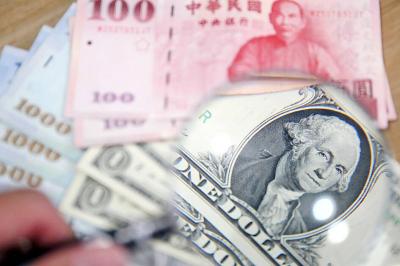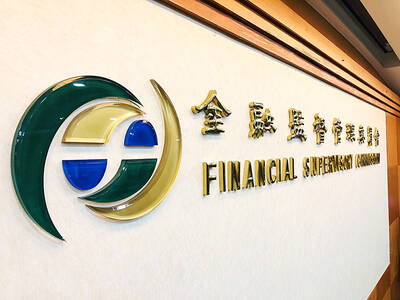The global semiconductor industry is to experience a second straight year of contraction in production value this year as the COVID-19 pandemic dampens demand for chips used in mobile phones and automotive devices, TrendForce Corp (集邦科技) said yesterday.
Demand from remote working and online learning, which boosted PC and server sales in the first half of the year, is also likely to ebb in the second half, leading to an opaque outlook for business prospects, the Taipei-based research house said in a report.
Inventory issues might also return in the third quarter, while seasonal demand in the fourth quarter is uncertain, as it largely depends on whether commercial activities will return to normal soon, the report said.
Overall, increases in supply chain inventory might lead to milder revenue growth for the semiconductor industry in the second half, compared with the first half, it said.
This year as a whole, the global semiconductor industry is expected to see its production value fall 1.3 percent annually to US$301.9 billion, excluding the memory chip segment, TrendForce said.
That was a downward revision from its pre-pandemic forecast in December last year of a 3.8 percent annual expansion to US$317.5 billion.
“Due to the impact of the pandemic, consumer electronics, [and] automotive and communications segments are at a higher likelihood of reporting contraction, while computing [and] industrial devices are to have better growth opportunities,” TrendForce said.
Specifically, demand for chips used in servers, commercial notebook computers and Chromebooks are on the rise, but demand for chips for smartphones, consumer electronics and automotive components are slumping, it said.
As smartphone chips and chips used in automotive electronics account for more than 50 percent of the semiconductor industry’s overall production value, their decline drags down the overall chip industry, it said.
TrendForce said it is conservative about the market outlook for the second half of the year.
Integrated device manufacturers (IDM) suffered a drastic decline in production and shipments in the first two quarters due to pandemic-induced factory shutdowns and logistics disruptions, the researcher said.
Poor demand for vehicles added to the slump, it said.
TrendForce said it has a more upbeat outlook about fabless companies and foundries, which are to outperform IDMs, because production at foundries has been spared by the pandemic, as their factories are in places that have been less affected by the virus, the researcher said.
Fabless companies have greater flexibility in adjusting chip specifications to cope with changes in consumer demand, which helps them better weather the crisis, it said.
Fabless companies and IDMs are major clients of foundries.

The US dollar was trading at NT$29.7 at 10am today on the Taipei Foreign Exchange, as the New Taiwan dollar gained NT$1.364 from the previous close last week. The NT dollar continued to rise today, after surging 3.07 percent on Friday. After opening at NT$30.91, the NT dollar gained more than NT$1 in just 15 minutes, briefly passing the NT$30 mark. Before the US Department of the Treasury's semi-annual currency report came out, expectations that the NT dollar would keep rising were already building. The NT dollar on Friday closed at NT$31.064, up by NT$0.953 — a 3.07 percent single-day gain. Today,

‘SHORT TERM’: The local currency would likely remain strong in the near term, driven by anticipated US trade pressure, capital inflows and expectations of a US Fed rate cut The US dollar is expected to fall below NT$30 in the near term, as traders anticipate increased pressure from Washington for Taiwan to allow the New Taiwan dollar to appreciate, Cathay United Bank (國泰世華銀行) chief economist Lin Chi-chao (林啟超) said. Following a sharp drop in the greenback against the NT dollar on Friday, Lin told the Central News Agency that the local currency is likely to remain strong in the short term, driven in part by market psychology surrounding anticipated US policy pressure. On Friday, the US dollar fell NT$0.953, or 3.07 percent, closing at NT$31.064 — its lowest level since Jan.

The New Taiwan dollar and Taiwanese stocks surged on signs that trade tensions between the world’s top two economies might start easing and as US tech earnings boosted the outlook of the nation’s semiconductor exports. The NT dollar strengthened as much as 3.8 percent versus the US dollar to 30.815, the biggest intraday gain since January 2011, closing at NT$31.064. The benchmark TAIEX jumped 2.73 percent to outperform the region’s equity gauges. Outlook for global trade improved after China said it is assessing possible trade talks with the US, providing a boost for the nation’s currency and shares. As the NT dollar

The Financial Supervisory Commission (FSC) yesterday met with some of the nation’s largest insurance companies as a skyrocketing New Taiwan dollar piles pressure on their hundreds of billions of dollars in US bond investments. The commission has asked some life insurance firms, among the biggest Asian holders of US debt, to discuss how the rapidly strengthening NT dollar has impacted their operations, people familiar with the matter said. The meeting took place as the NT dollar jumped as much as 5 percent yesterday, its biggest intraday gain in more than three decades. The local currency surged as exporters rushed to